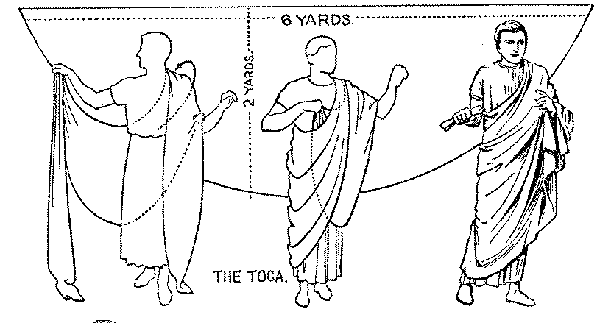Roman Clothing
In Rome society was becoming classified: more classes upper, lower, middle, etc, and therefore needed more to distinguish it. During this time cutting and sewing became more prevalent in the building of clothing and became more wasteful by getting rid of some of the bulk of fabric. This mirrors the excessiveness that Romans showed in other aspects of their life.
Men's Clothing
Tunic - Simple chiton usually sewn worn over a loin cloth. Giant t-shirt or simple pillowcase with neck holes and arm holes usually calf-length
-
Later, the sleeves were additional fabric with a neck slit
Clavi - Vertical stripe or band of color applied to the garment as a symbol of who you were
Tyre - dye used to create purple stripes on garments
Toga - Roman version of the himation. Large round rectangle of fine-woven wool worn only by men in public. More circular bottoms than the greek himation. Huge amount of fabric (up to 10 yards) that caused the wearer to move with care since it was only wrapped and could fall off.
-
Toga Pura - plain unbleached white, simple wool only worn by male citizens over the age of 16
-
Toga Candida - Bleached white, worn by candidates in office
-
Toga Praetexta - Worn by sons of nobility and certain adult magistrates and has a purple border
-
Toga Pulla - Black or dark colored may have been worn for mourning
-
Toga Picta - Purple toga with gold embroidery worn for special occasions for distinguished individuals
-
Toga Trabea - Multi-colored, striped worn by religious officials who prophesized the future
-
Umbo - pouch formed by wrapping the toga near the waist. Can be used to keep items in
-
Sinus - The longer drape that wraps around the shoulders. Can be used as a hood for protection
Bulla - amulet or necklace that wards of infertility for young children of nobility
Dalmatic - ankle length tunic with gigantic full sleeves worn a lot by priests (even today)
Bracchae - Leggings worn underneath a tunic by the lower classes for warmth. Originally from the military.
Sagum - Short knee length or calf length cape worn over one shoulder and pinned (chlamys) with a fibula
Paladumentum - Giant version of a sagum. Seen worn by military generals
Men's Hairstyles
"Brutus Hair Cut" - cut short and brushed forward.
Early Imperial - Brutus cut and clean shaven
Late Imperial- Beards (neck beards) and medium-lenth hair dressed with fillets were seen
Women's Clothing
Women’s Tunic or Tunica many times had sleeves
Stola - outer tunic with straps no sleeves
Palla - Based on the Greek himation and looks similar to toga. Smaller amount of fabric and more simply draped
Strophium - “small twisty thing” narrow piece of fabric tied around the breasts for support: bra
Subligaria - loin cloth or underwear
Calcei - Shoes or boots (whole foot covering)
Solea - Leather laced sandal
Women's Hairstyles
Big and over the top
Rats - fake hair pieces to add to make it bigger
Used braiding and twists
Mostly blondes, women would bleach their hair
Really late in period - women would deck out in jewelry and gold and hair pins/fillets
Men and women used makeup to reduce the effect of age
MILITARY
Caliga - boots worn by the military
Lorica - breastplate worn by military made of hammered metal or bronze held together with straps and buckles
Lambrequins - Leather pieces attached to Lorica to cover and protect the genitals while giving full range of motion
 Elements of the Toga |  wrapping the toga |
|---|---|
 Senator Toga |  Emperor Titus |
 wrapping the toga |
 Roman Women |  Stolla and Palla |
|---|---|
 Roman Women |  Subligaria |